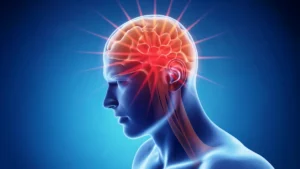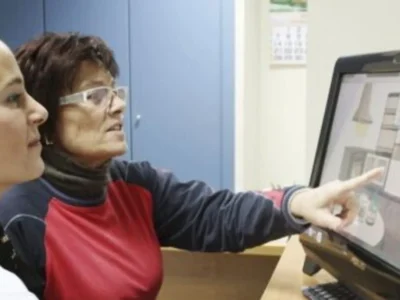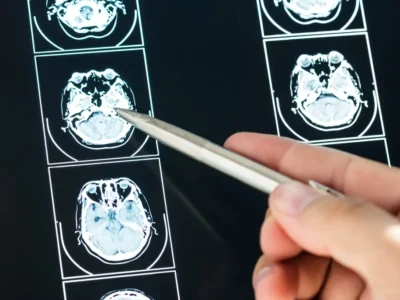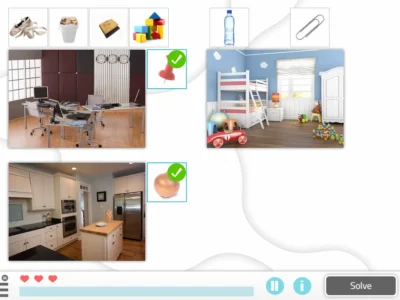Martha Valeria Medina Rivera, neuropsychologist at NeuronUP, reveals to us how diaschisis influences cognitive sequelae after a TBI and the key role of neuropsychology in their rehabilitation.
Introduction
Traumatic brain injury (TBI) is one of the leading causes of disability and mortality worldwide. Its most frequent origins include falls and traffic accidents, the latter weighing much more heavily in low- and middle-income countries, where they account for up to 56% of cases, compared with 25% in high-income countries, since each country’s road regulation determines its incidence. Globally, it is estimated that around 69 million TBIs occur each year, with a threefold greater burden in low-resource countries (Halalmeh et al., 2024).
This outlook reflects the complexity of TBI, especially in motor vehicle accidents, where injuries not only cause focal damage but also distant functional disconnections. Here the concept of diaschisis arises, key to understanding why many cognitive alterations do not depend solely on the damaged area, but on the disconnection of wider brain networks.
Therefore, the aim of this article is to analyze the relationship between TBI caused by traffic accidents and the phenomenon of diaschisis, as well as the role of neuropsychology as a key component to optimize intervention strategies and improve the functional prognosis of affected individuals.
Traumatic brain injury (TBI)
TBI is understood as a structural injury or a physiological disruption of brain function caused by an external force (Mckee & Daneshvar, 2015).
According to the clinical guideline of the U.S. Department of Veterans Affairs and the Department of Defense (VA/DoD, 2009 in Mckee & Daneshvar, 2015), the diagnosis is established when at least one of the following manifestations is observed: loss or alteration of consciousness, post-traumatic amnesia, confusion or slowed thinking, transient or persistent neurological changes, and evidence of intracranial injury.
The severity of TBI is mainly classified with the Glasgow Coma Scale (GCS), the duration of loss of consciousness (LOC) and of post-traumatic amnesia (PTA):
- Mild: GCS 13–15, LOC < 1 h, PTA < 24 h.
- Moderate: GCS 9–13, LOC 1–24 h, PTA 1–7 days.
- Severe: GCS 3–8, LOC > 24 h, PTA > 1 week.
Although most cases (75–85%) are mild, between 15–30% of people develop persistent symptoms that affect cognition, behavior and emotional state, which shows that even the mildest forms can have long-lasting consequences (Mckee & Daneshvar, 2015).

Subscribe
to our
Newsletter
Connection between cognitive alterations and specific brain damage post-TBI
The cognitive and behavioral changes after a TBI are frequent and significantly affect the individual’s daily life (Mckee & Daneshvar, 2015; Halalmeh et al., 2024). To understand this complexity, it is necessary to describe the injury mechanisms and the neurophysiological processes underlying TBI, especially in the context of motor vehicle accidents (Azouvi et al., 2017; Le Prieult et al., 2017; Halalmeh et al., 2024).
During a crash, the brain is exposed to acceleration-deceleration forces, direct impacts and rotational movements (Azouvi et al., 2017). These mechanisms cause two main types of damage:
- Focal injuries: inflammation, contusions, hematomas or internal hemorrhages, which mainly affect the frontal and temporal regions (Mckee & Daneshvar, 2015).
- Diffuse injuries: affect the white matter, especially the corpus callosum and frontostriatal and temporoparietal connection tracts, disrupting large-scale neural networks (Mckee & Daneshvar).
Added to this is a cascade of secondary processes that intensify brain changes: excitotoxicity from excess glutamate, mitochondrial dysfunction, oxidative stress, reduced cerebral blood flow, edema, neurotransmitter imbalance and microglia-mediated neuroinflammation (with both harmful and reparative effects) (Mckee & Daneshvar, 2015).
Focal and diffuse injuries and secondary processes form the neurobiological basis of the cognitive and behavioral difficulties observed after TBI. The most common cognitive sequelae are usually associated with the areas affected by the injury and include difficulties (Halalmeh et al., 2024).
Diaschisis and its relationship with TBI
As we have seen, TBI can damage brain regions involved in specific cognitive functions; however, we now know that there is no strict localizationism that uniquely assigns a function to a single area. The brain works as an interconnected network and, in many cases, cognitive process alterations are observed even when the injury is not located in the region usually related to those functions.
This phenomenon, described by von Monakow in 1914 as diaschisis, consists of a decrease in neuronal excitability in areas distant from the lesion due to interruption of connection pathways (Carrera & Tononi, 2014).
Diaschisis acts as a defensive strategy: after the injury, wide regions enter a state of hypoexcitability or “shock phase” that can progressively reverse depending on the extent of the damage and brain plasticity. This phenomenon explains why some people show motor, sensory or cognitive changes that do not correspond to the anatomical area injured, since it can involve not only the cortex but also deep structures such as the thalamus and cerebellum, which are fundamental for motor and cognitive organization (Sarmati, 2022).
In animal models, an acute transhemispheric diaschisis has also been described, characterized by transient contralateral hyperactivity in the first 24–48 hours, which opens the possibility of early interventions to modulate neuronal plasticity (Le Prieult et al., 2017).
More recently, it has been suggested that diaschisis also includes metabolic adaptations. Boggs et al. (2024) describe a pattern of focal metabolic diaschisis in which regions contralateral to the lesion show biochemical changes that appear aimed at improving mitochondrial function, reducing oxidative stress, preserving neuronal integrity and preventing glial degeneration. This finding underlines that diaschisis can also act as a protective mechanism, modulating energy metabolism to compensate for the dysfunction produced by the initial TBI damage.
It is important to differentiate the phenomenon of diaschisis from distal lesions such as diffuse axonal injury, which is produced by tensile forces that directly damage axonal membranes (Azouvi et al., 2017; Le Prieult et al., 2017; Halalmeh et al., 2024), since in diaschisis the focus is mainly on functional disconnection rather than a rupture per se (Le Prieult et al., 2017).
Therefore, understanding diaschisis is key to explaining why cognitive and emotional difficulties after a TBI do not depend solely on the primary lesion, but on a network effect that alters the brain’s overall efficiency. Clinically, it can last weeks, months or even a lifetime, which underscores the importance of guiding brain reorganization with appropriate neurocognitive interventions that respect the timing of the nervous system (Sarmati, 2022).
Cognitive difficulties after TBI and the role of diaschisis
The cognitive and behavioral consequences of a traumatic brain injury (TBI) are varied and depend both on direct damage and on secondary processes that affect the dynamics of brain networks. Among these, diaschisis is especially relevant, since it explains how functions distant from the injured area can be involved due to the functional disconnection of interrelated circuits (Carrera & Tononi, 2014).
Memory difficulties after a TBI
Memory difficulties are among the most persistent after a TBI. Episodic memory is characterized by slower learning, accelerated forgetting and greater vulnerability to interference; likewise, prospective and autobiographical memory also show significant difficulties (Halalmeh et al., 2024). These changes not only reflect direct damage to frontotemporal regions, but can also result from disconnection between the hippocampus and prefrontal areas caused by diaschisis, compromising efficient encoding and retrieval of information.
Attention and processing speed difficulties after a TBI
People with TBI often show difficulties with sustained, divided and selective attention, often accompanied by mental fatigue. Although this is generally associated with diffuse axonal injury, it can also be explained by hypoexcitability of frontoparietal networks linked to diaschisis, which limits the ability to allocate attentional resources effectively (Le Prieult et al., 2017). In parallel, processing speed is slowed even in simple tasks, not only due to structural white matter damage but also because of disruption of interhemispheric connectivity (Azouvi et al., 2017).
Executive function difficulties after a TBI
Executive functions are also compromised after a TBI. Although direct frontal damage is a clear factor, diaschisis helps explain why even lesions in temporal or subcortical areas generate executive alterations: when communication with prefrontal networks is interrupted, self-regulation and adaptive functional capacity become more difficult (Halalmeh et al., 2024).
Finally, after a TBI, social cognition and behavior can also present difficulties in emotion recognition and interpretation of social cues, which directly impacts interpersonal relationships.
In addition, behavioral changes such as disinhibition, impulsivity and irritability may occur, as well as apathy or lack of initiative, affecting family, social and work reintegration (Azouvi et al., 2017). Here diaschisis plays an explanatory role by showing how alterations in distributed networks —beyond the focal lesion— influence complex social and emotional processes.
The importance of neuropsychology in the management of TBI
Given the complexity of the structural and functional changes already mentioned, often modulated by diaschisis, neuropsychology plays a central role both in assessment and intervention. Halalmeh et al. (2024) highlight the importance of intervention neuropsychology to prevent progression to post-concussion syndrome (PCS) and other persistent changes. Even in mild TBIs, some people develop lasting symptoms such as headaches, memory problems or emotional disturbances.
Early psychoeducational interventions have proven effective in reducing symptom chronification, changing negative expectations and guiding gradual return to activities. In turn, cognitive rehabilitation programs allow training of functions such as attention, memory and executive functions with personalized strategies. These are complemented by psychotherapy, particularly cognitive-behavioral therapy, which helps manage the emotional and behavioral symptoms associated with TBI.
This comprehensive approach not only improves functional prognosis but also optimizes the use of healthcare resources, reducing the need for more invasive interventions in later phases.
Conclusion
TBI in motor vehicle accidents is a complex neurological event with consequences that go far beyond visible focal damage. Incorporating the concept of diaschisis allows better understanding of why cognitive and behavioral difficulties do not always directly correspond to the injured area, but reflect the alteration of interconnected brain networks.
This phenomenon, which includes not only processes of functional inhibition but also metabolic adaptations, shows that the brain responds to injury with mechanisms of both vulnerability and compensation. Thus, functions such as memory, attention, processing speed or executive functions can be compromised, even when there is no direct lesion in the areas traditionally associated with them.
Taken together, the study of TBI and diaschisis reminds us that the brain operates as a networked system. Recognizing this perspective is key to moving toward more realistic explanatory models of the global impact of these injuries.
Therefore, an interdisciplinary model where neuropsychology, neurology, physiotherapy and occupational therapy work together becomes essential. In this regard, it is important to emphasize that neuropsychology has an essential role in assessment and intervention after a TBI, as it allows precise identification of affected functions and understanding of how they interact with cerebral disconnection phenomena; this not only yields each person’s cognitive profile but also lays the foundations for designing individualized and evidence-based intervention strategies.
References
- Azouvi, P., Arnould, A., Dromer, E., & Vallat-Azouvi, C. (2017). Neuropsychology of traumatic brain injury: An expert overview. Revue Neurologique, 173(7), 461–472. https://doi.org/10.1016/j.neurol.2017.07.006
- Boggs, R. C., Watts, L. T., Fox, P. T., & Clarke, G. D. (2024). Metabolic diaschisis in mild traumatic brain injury. Journal of Neurotrauma, 41(13–14), e1793–e1806. https://doi.org/10.1089/neu.2023.0290
- Carrera, E., & Tononi, G. (2014). Diaschisis: Past, present, future. Brain, 137(9), 2408–2422. https://doi.org/10.1093/brain/awu101
- Halalmeh, D. R., Salama, H. Z., LeUnes, E., Feitosa, D., Ansari, Y., Sachwani-Daswani, G. R., & Moisi, M. D. (2024). The role of neuropsychology in traumatic brain injury: Comprehensive literature review. World Neurosurgery, 183, 128–143. https://doi.org/10.1016/j.wneu.2023.12.069
- Le Prieult, F., Thal, S. C., Engelhard, K., Imbrosci, B., & Mittmann, T. (2017). Acute cortical transhemispheric diaschisis after unilateral traumatic brain injury. Journal of Neurotrauma, 34(5), 1097–1110. https://doi.org/10.1089/neu.2016.4575
- Mckee, A. C., & Daneshvar, D. H. (2015). The neuropathology of traumatic brain injury. Handbook of Clinical Neurology, 127, 45–66. https://doi.org/10.1016/B978-0-444-52892-6.00004-0
- Sarmati, V. (2022.). Diaschisis. Stroke Therapy Revolution. Accessed August 25, 2025, from https://www.stroke-therapy-revolution.es/diasquisis/
- Wiley, C. A., Bissel, S. J., Lesniak, A., Dixon, C. E., Franks, J., Beer Stolz, D., Sun, M., Wang, G., Switzer, R., Kochanek, P. M., & Murdoch, G. (2016). Ultrastructure of diaschisis lesions after traumatic brain injury. Journal of Neurotrauma, 33(20), 1866–1882. https://doi.org/10.1089/neu.2015.4272
Frequently asked questions about TBI and diaschisis
1. What is traumatic brain injury (TBI)?
A traumatic brain injury is an injury to the brain caused by an external force, such as a blow, shake or direct impact to the head. It can be mild, moderate or severe depending on level of consciousness, duration of amnesia and presence of structural damage.
2. What is diaschisis and how is it related to TBI?
Diaschisis is a phenomenon in which brain areas distant from the primary lesion reduce their activity due to functional disconnection of neuronal networks. In a TBI, it explains why cognitive deficits may appear in regions not directly injured.
3. What are the most common cognitive sequelae after a TBI?
The most frequent include memory, attention, processing speed, executive function and social cognition impairments. These can durably affect daily life and the user’s social and work reintegration.
4. Why is neuropsychology important in the approach to TBI?
Neuropsychology assesses the cognitive and emotional impact of TBI and implements personalized programs of cognitive rehabilitation, psychoeducation and behavioral therapy to promote functional recovery and prevent chronic sequelae.
5. What cognitive stimulation techniques are used in post-TBI rehabilitation?
Training programs focused on memory, attention and executive functions are used, adapted to the user’s needs, combined with psychotherapy, compensatory techniques and interdisciplinary support (physiotherapy and occupational therapy).
If you liked this article about traumatic brain injury from motor vehicle accidents and diaschisis: neuropsychological impact, you will surely be interested in these NeuronUP articles:
“This article has been translated. Link to the original article in Spanish:”
Traumatismo craneoencefálico por accidente automovilístico y diasquisis: impacto neuropsicológico







 Neurodevelopmental disorders and a gender perspective: keys to a more equitable diagnosis and intervention
Neurodevelopmental disorders and a gender perspective: keys to a more equitable diagnosis and intervention
Leave a Reply